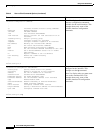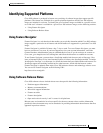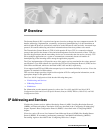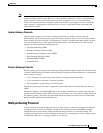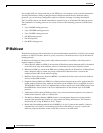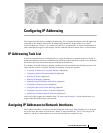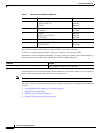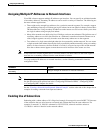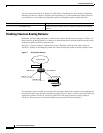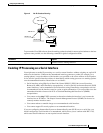
IP Overview
IP Multicast
IPC-4
Cisco IOS IP Configuration Guide
For example, RIP uses a hop-count metric and IGRP uses a five-element vector of metric information.
If routing information is being exchanged between different networks that use different routing
protocols, you can use many configuration options to filter the exchange of routing information.
The Cisco IOS software can handle simultaneous operation of up to 30 dynamic IP routing processes.
The combination of routing processes on a router consists of the following protocols (with the limits
noted):
• Up to 30 IGRP routing processes
• Up to 30 EIGRP routing processes
• Up to 30 OSPF routing processes
• One RIP routing process
• One IS-IS process
• One BGP routing process
IP Multicast
IP multicast routing provides an alternative to unicast and broadcast transmission. It allows a host to send
packets to a subset of all hosts, known as group transmission. IP multicast runs on top of the other IP
routing protocols.
In addition to IP multicast routing itself, other multicast features are available, each discussed in a
separate chapter, as follows:
• Source Specific Multicast (SSM) is an extension of IP multicast where datagram traffic is forwarded
to receivers from only those multicast sources to which the receivers have explicitly joined.
• Bidirectional PIM is a variant of the PIM suite of routing protocols for IP multicast. In bidirectional
mode, datagram traffic is routed only along a bidirectional shared tree that is rooted at the
rendezvous point (RP) for the multicast group.
• Multicast Source Discovery Protocol (MSDP) is a mechanism for the router to discover multicast
sources in other PIM domains.
• Pragmatic General Multicast (PGM) is a reliable multicast transport protocol for applications that
require ordered, duplicate-free, multicast data delivery from multiple sources to multiple receivers.
The PGM Host feature is the Cisco implementation of the transport layer of the PGM protocol, and
the PGM Router Assist feature is the Cisco implementation of the network layer of the PGM
protocol.
• Unidirectional link routing (UDLR) provides a way to forward multicast packets over a physical
unidirectional interface, such as a satellite link.
• The Multicast Routing Monitor (MRM) feature is a management diagnostic tool that provides
network fault detection and isolation in a large multicast routing infrastructure. This feature is
described in the “Using IP Multicast Tools” chapter.
• Router-Port Group Management Protocol (RGMP) is a Layer 2 protocol that enables a router to
communicate to a switch (or a networking device that is functioning as a Layer 2 switch) the
multicast group for which the router would like to receive or forward traffic.



